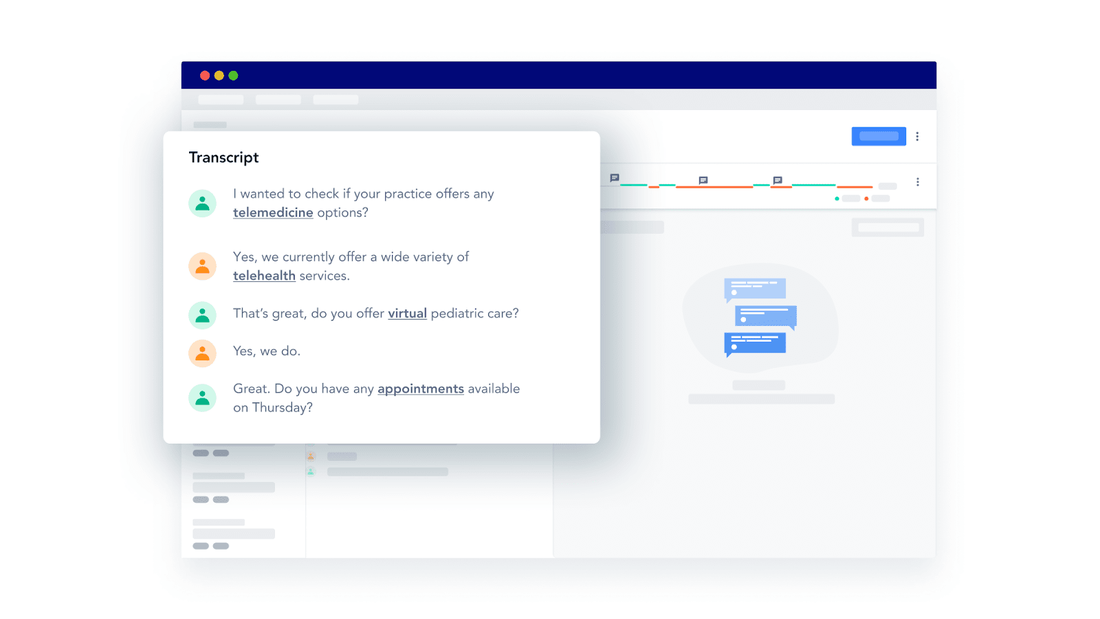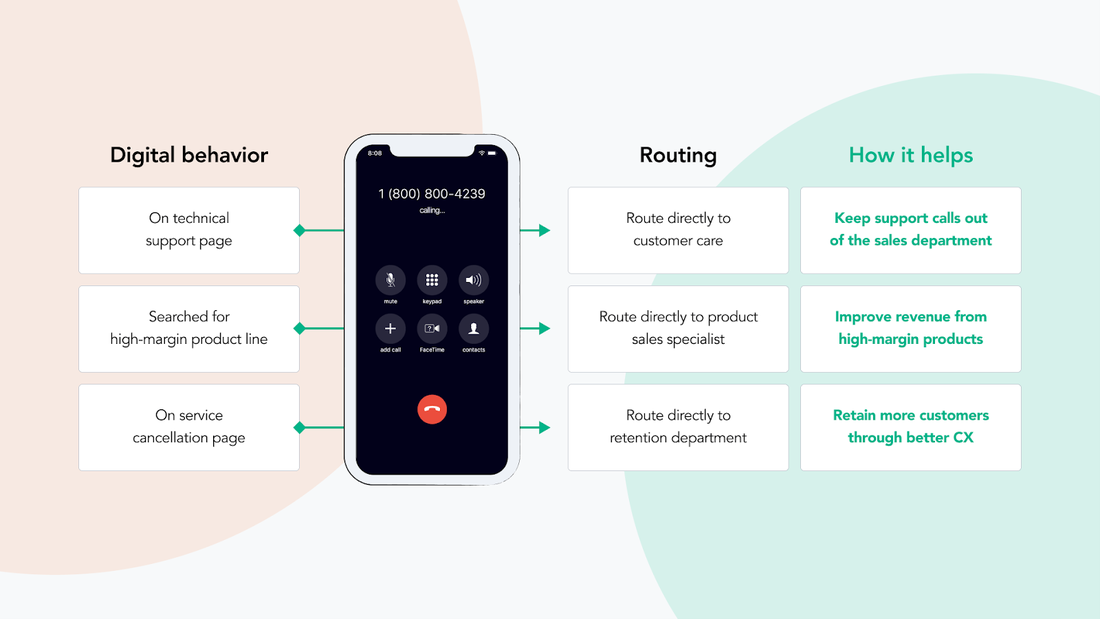
COVID-19 has caused radical shifts in the way patients engage with healthcare providers. To thrive in 2023, healthcare marketers need to anticipate future trends and adapt their strategies accordingly.
Below, I list some of the most important trends healthcare marketers will see in 2023, as well as how a call tracking solution can help you capitalize on them.
The healthcare industry makes up a significant portion of total US digital ad spend, and it has been steadily climbing over the past three years. In 2022, healthcare digital ad spending increased by 14.3%, reaching $15.84 billion. That figure is projected to increase by12.3% in 2023 to reach $17.79 billion.
In addition, healthcare providers are allocating 57.5% of their total ad spend to mobile devices. This move comes in response to more patients engaging with healthcare providers on mobile devices (more on this later).
As the digital advertising landscape continues to become more competitive — and cost per lead continues to rise — healthcare marketers will face increasing pressure to prove their digital marketing ROI and optimize their spend to acquire more patients at a lower cost.
For many years, patients have increased their mobile device usage to contact healthcare providers, download healthcare apps, and attend telehealth appointments. There was an even more dramatic increase in mobile usage in 2020, as patients limited their in-person interactions with healthcare providers.
58% of smartphone users have downloaded a health app and 62% have used a smartphone to research a health condition. In addition, 85% of patients use their smartphones to contact their healthcare provider. As this channel continues to grow in popularity, healthcare marketers have shifted the majority of the advertising budget to target mobile device users.
Providing a seamless mobile experience — online and over the phone — will be critical for 2023.
Once a patient has converted, their input on your healthcare services is invaluable when it comes to convincing others to choose you as well. Reviews provide an outlet for your current patients to, hopefully, advocate for you and develop a deeper sense of trust with those who are on the market. Your customers will have the opportunity to discuss topics like appointment punctuality, the level of care they received, how attentive their physicians were, etc. Remember, reviews can be a blessing and a curse (even if you do everything right by the patient) so review management is just as important as making them available. Be sure to respond professionally to disgruntled patient/customer reviews to deescalate the situation should the situation arise. We dig deeper into that in the SEO strategy later in the post.
The best ways to deliver high-quality content that attracts leads in 2023 will be:
Simple yet effective techniques on your website can make a world of difference. You’d be surprised by the snowball effect for decisions you do or do not make when it comes to managing your SEO. Starting with the basics, your practice’s name and affiliated doctors, address and contact information should be included. All of this is usually on your “Contact Page” if you have one, but can also be included in the footer of every page along with links to your social media.
The ease of navigating your website is also important as it can be perceived as a reflection of your practice. If you can't manage a website properly, why should they trust you with their health care needs? If the User Interface, or UI, is complicated, it can detract potential clients to give up and look elsewhere. There are UI/UX testing services that can assist you to make sure your site’s design is optimal and prevent lost traffic. Try to remember, an improved UI will mean more website visits which will turn into more office visits!
Lastly, targeting local traffic comes with multiple perks! The ads you’re running can be designed to target people searching for your services locally, which is what you want anyway. This prevents your ad spend from getting out of control because it was targeting the entire internet and not potential local traffic you truly want. Researching for keyword phrases similar to “doctors near me” or “doctors taking new patients near me” will bring in the web traffic to your site and then the foot traffic into your healthcare center.
See how one thing is leading to another? We truly hope these easy and successful strategies connect you with the people you’re hoping to provide care for.
Video marketing is a great opportunity to promote both the staff that works in your healthcare center and the facility they work in. Interviews with the medical staff or current patients can be created to add another level of personalization. Video marketing is more captivating and adds a personal touch to your campaigns and initiatives. If you can interview an actual patient to discuss their experiences, or healthcare workers to talk about the passion they have for their job, it can be utilized throughout your website and social media to attract more patients. If your service is more specialized, videos about your specific procedures, processes, and their outcomes can be created to educate your potential patients ahead of time and alleviate any fears they may have about following through.
Social media is an amazing outlet for any healthcare provider. In almost every industry it’s become quite the necessity and no longer a “nice to have” so if you haven’t delved into it yet, it’s never too late! There’s no need to sign up for every platform either, at least not to start. It really depends on the audience you’re trying to attract and is based on the services you provide. Once you’ve chosen a platform, really invest in it, and give it a chance to gather data. This is going to take time, but also gives you an occasion to be creative!
Facebook and Instagram are good starter platforms. They attract a pretty wide age range of users and provide a combination of written content, imagery, video, geolocation, and reviews. They also allow you to create digital ads as a way to gather more followers, further promote your services, and hopefully draw more customers. If you want to take a more professional or educational approach, LinkedIn would be preferred.
The main purpose of social media is to create awareness and boost brand visibility for potential customers so make sure the messaging you’re using is consistent with whatever you’re promoting on your website. It also allows you to tell your stories in an informal setting. You get to better showcase your talents, successes, the staff, or even the facility itself.
Every patient’s needs are going to be different so the way they want to interact and which of your channel options will be different too. A great sense of empathy needs to be considered when it comes to how your patients want to communicate, so you’ll need to be flexible, receptive, and adaptable to your patients' needs. With 88% of them making phone calls to schedule appointments after doing their own research online, it’s important to personalize the full digital-to-call experience and make it as seamless as possible.
In a way, the future is here, now that we can ask our mobile or smart home devices to turn on our lights, open the garage door, or answer questions. As their capabilities have evolved, the complexity of questions they can answer has adapted as well. This is why healthcare marketers need to start investing efforts now so as not to fall behind as voice search continues to develop. Consumers are starting to rely on voice search to find the nearest healthcare providers so making sure your internet presence is optimal, and your contact information is up to date and available is very important. The same mobile devices that consumers are using to find a healthcare provider are also being used to track exercise routines, steps, and even heart rates through watches. The immediate access to their own data is allowing for customers to make better decisions about their health and you want to make sure YOU’RE the one greeting them at your doors to give them the care they need.
Inbound phone calls to health systems are up 55% year-over-year and calls to healthcare providers are up 20% year-over-year. With in-person interactions limited by shelter-in-place orders, patients rely on the call channel to ask about COVID-19 safeguards, make inquiries about procedures, and schedule appointments.
Though lockdown restrictions have eased, many patients still restrict their in-person interactions due to safety concerns. Therefore, call volume will remain higher than it was during previous years, as patients will use this channel to get information and make appointments.
Telehealth appointments have been increasing over the past few years. The COVID-19 pandemic only accelerated patient adoption. Some of the largest telehealth providers in the US reported a 60-80% increase in telemedicine appointments since the COVID-19 outbreak.
To adapt to this shift, healthcare marketers need to create seamless telehealth experiences for patients. You need to ensure the entire process of scheduling a telehealth appointment is frictionless, from finding information about telehealth on your website or IVR, to calling to schedule an appointment, to following up post-appointment. And you need to commit to these best practices in the long term, since 80% of patients are likely to have another virtual visit, even post COVID-19.
Going hand-in-hand with the last trend, healthcare patients will demand seamless omnichannel experiences across their entire journey. To earn their business, you’ll need to ensure they feel valued and known every step of the way.
83% of consumers say they require a positive experience to remain loyal to a brand — regardless of the channel they’re engaging on. If healthcare marketers fail to provide seamless experiences for patients, the stakes are high. 82% of consumers would switch providers as a result of a bad experience.
To get an edge over the competition in 2023, healthcare providers need to embrace personalization across channels. This means providing a seamless experience as patients transition from online research to phone calls to in-person interactions. For example, serving patients with web ads targeted to the service they researched on your site, or automatically routing their call to their nearest clinic location.
The trends above paint a bigger picture of how healthcare patient behavior is changing. In 2023, in-person interactions with healthcare providers will continue to be limited due to COVID-19, placing increased importance on the call channel.
With more patients researching online first and calling agents and locations to ask questions and make appointments, healthcare marketers need to have a strategy in place to ensure that they’re providing a seamless experience over the phone. As I mentioned above, expectations for the patient journey are at an all-time high — and this includes the call channel. Failing to deliver frictionless call experiences will cost you patients.
HIPAA- and PCI-compliant call tracking and analytics solutions like Invoca allow you to understand the webpages, marketing campaigns, and keywords driving not only the most calls — but the highest quality calls to your agents and locations. This allows you to optimize your marketing spend for the programs that are truly driving the most patients.
For instance, a certain elective surgery may be driving a high volume of calls to your locations. However, once you use a call tracking solution, you may discover many of these calls are not appointment-related — they’re billing issues. You could then decrease spend on this campaign, and instead allocate it to one that’s driving more appointment-related calls. This increases the overall revenue potential and quality of the calls coming into your phone lines.
Call tracking and analytics solutions like Invoca help you create seamless call experiences that increase patient acquisition. They provide detailed reports on answer inbound call rates and call handling performance at each location or call center that you can use to detect patient experience issues.
For example, you can see if your calls are going unanswered at specific locations and what days and times those unanswered calls occur. You can then diagnose if your marketing is sending calls to locations when they are closed or understaffed, and make adjustments.
Call tracking and analytics platforms like Invoca give you a searchable database of call recordings and transcriptions that you can tap into. This allows you to see what’s occurring on the inbound calls your marketing is driving to call centers and locations and use these insights to make optimizations that drive more appointment conversions.
If unconverted calls are an issue, you can analyze your recordings and transcriptions to see if your locations, call centers, and remote agents are saying the right things when patients call. You can then pinpoint any issues. For instance, are they accurately describing the safety precautions you’re enacting at your clinics? Are they failing to mention telehealth appointment options? You can then take steps to remedy them. In addition, you can share these recordings and transcriptions with your locations and/or call centers to use as coaching tools to improve performance.

You can also use transcriptions to discover common caller questions and concerns — such as FAQs on telehealth appointments — and add them to your website and product pages to get more SEO visits and improve conversion rates.
If you’re experiencing unmanageably high call volumes, you can also consider using your call tracking solution to set up an IVR (interactive voice response). You can configure an IVR to ask callers why they’re calling, route them to the best destination based on their responses, provide answers to common questions (such as FAQs about your COVID-19 precautions and telehealth appointments), and more.
You can also set up dynamic routing rules, in tandem with or independent of your IVRs. Below are several call routing configurations that can improve conversion rates for healthcare providers:

Want to learn more about how call tracking data can enhance the patient experience? Check out The 2022 Buyer Experience Benchmark Report.

The original version of this page was published at: https://www.invoca.com/blog/healthcare-trends-call-tracking
Invoca for Healthcare enables healthcare providers to capture detailed analytics on a new patient’s full journey. This includes the marketing campaign that drove initial interest, the specific webp... Read more
When the ball drops on New Year’s Eve, you probably won’t be thinking about snooze-worthy stuff like popping a new bottle of bubbly or smooching your sweetheart — ...read more
Economists are predicting a recession in 2023 and marketers know all too well what this means: their budgets will be under pressure. A recent study found that about a third ...read more
Between tightening media budgets, dwindling resources, and shrinking teams, marketers are facing an unprecedented uphill battle. It can seem like the only thing that is ramping up ...read more
The third-party tracking cookie has been crumbling since 2018 and it’s usefulness for audience tracking has waned significantly since. Most browsers block third-party cookies ...read more